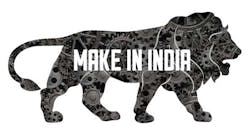The lion roared at this year's Hannover Messe trade fair. Only the deaf and blind could have missed the message from Indian Prime Minister Narendra Modi on his desire to draw manufacturing investment to his country: "Make in India," symbolized by lions, was plastered on billboards, buses, buildings and flags all around the German city.
"Make what?" you might ask. The answer is just about everything -- cars, planes, biotechnology, electrical machinery, chemicals, leather products, textiles and much more.
Modi confronts an enormous demographic challenge: India has 800 million young people in a nation of more than 1.25 billion, and they will need jobs, -- lots of them. Modi hopes that the manufacturing sector can add 100 million new jobs in India. "[I]f we want to fulfill the dreams of our youth, we must turn our industry into a manufacturing hub for the world and an engine for employment at home," he told attendees at Hannover Messe's opening ceremony.
Modi's goal is to have India's manufacturing sector grow from 16% to 25% of GDP by 2022.While India is already making strides as a manufacturing nation (it grew from the No. 14 global manufacturer in 2003 to No. 11 in 2013), Modi is pushing for greatly increased foreign investment in his country. The carrot for that investment, as he stated: "Our scale of transformation is vast; therefore, the opportunities we offer are huge."
But Modi acknowledged the 800-pound gorilla in the lion's den -- a notoriously difficult business environment. He told manufacturers in Hannover that his government was in the midst of sweeping legislative and regulatory reforms that will create "a stable economic environment that inspires confidence at home and abroad."
In a January visit to India, Secretary of State John Kerry underlined the need for continued action by India to improve its business environment. He noted, "Capital works best with confidence." The secretary said the Modi government's efforts to streamline and speed up the regulatory climate will "have a profound impact on people's decisions as to whether or not to invest…."
Modi stressed that India was making the kinds of investments that make it possible for manufacturers to operate efficiently. His 2015 budget calls for $11.4 billion in additional infrastructure investments. India's railways, the backbone of the country's transportation system, would get a proposed $137 billion for modernization over the next five years. The system currently carries 3 million tons of freight and 23 million passengers daily.
India will need a major boost in its energy production in order to power not only a larger industrial footprint but also a growing middle class. Already, India is the fourth- largest consumer of crude oil and petroleum products in the world. To help meet its growing energy appetite, India has set a target of 75 gigawatts of new energy capacity from renewables and clean energy over the next seven years.
One U.S. company that is expanding its Indian portfolio is Ford (IW 1000/25). The automaker opened a $1 billion manufacturing facility in Sanand, Gujarat, Modi's home state, in March. The new plant will double Ford India's manufacturing capacity to 610,000 engines and 440,000 vehicles, and bring an employment boost of 5,000 to its existing workforce of 11,500.
GE (IW 1000/21) is also investing in India. In February, GE opened a $200 million factory in Pune that the firm called its first application of the "brilliant factory." The concept uses the industrial internet to combine advanced machinery and computers in the facility with supply, service and distribution partners. The factory, which employs 1,500, will manufacture products for four different GE businesses -- jet engines, locomotive technology, wind turbines and water treatment units.
Trade between the U.S. and India has grown by 60% in recent years to some $100 billion annually. That compares to $560 billion a year with China. In a visit to India this past January, President Obama called the U.S.-India relationship "defined by so much untapped potential." American manufacturers are hoping that potential in the coming years becomes a profitable reality.



